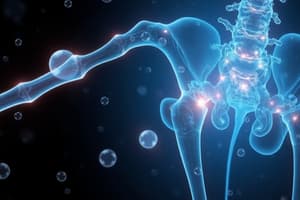Podcast
Questions and Answers
What is one of the major risks associated with Hormone Replacement Therapy (HRT)?
What is one of the major risks associated with Hormone Replacement Therapy (HRT)?
- Improved cardiovascular health
- Cerebrovascular accidents (correct)
- Osteoporotic fractures
- Increased bone density
What is the primary action of HRT in postmenopausal patients?
What is the primary action of HRT in postmenopausal patients?
- Increasing blood circulation
- Enhancing calcium absorption
- Inhibiting bone resorption (correct)
- Stimulating osteoblast activity
Which of the following is contraindicated for patients considering HRT?
Which of the following is contraindicated for patients considering HRT?
- History of venous thromboembolism (correct)
- History of osteopenia
- Low estrogen levels
- Age over 50
What is a specific recommendation for prescribing HRT?
What is a specific recommendation for prescribing HRT?
What does the Black Box Warning for HRT indicate?
What does the Black Box Warning for HRT indicate?
What is the primary cause of primary osteoporosis?
What is the primary cause of primary osteoporosis?
Which of the following treatments is commonly used to prevent fragility fractures in osteoporosis?
Which of the following treatments is commonly used to prevent fragility fractures in osteoporosis?
What condition is NOT typically associated with secondary osteoporosis?
What condition is NOT typically associated with secondary osteoporosis?
What is the recommended duration for pharmacologic treatment with bisphosphonates?
What is the recommended duration for pharmacologic treatment with bisphosphonates?
Why is it suggested to take a drug holiday after five years of bisphosphonate treatment?
Why is it suggested to take a drug holiday after five years of bisphosphonate treatment?
Which of the following factors is not considered when treating women 65 years and older with osteopenia?
Which of the following factors is not considered when treating women 65 years and older with osteopenia?
What does dual-energy x-ray absorptiometry (DEXA) primarily measure in osteoporosis diagnosis?
What does dual-energy x-ray absorptiometry (DEXA) primarily measure in osteoporosis diagnosis?
Which of the following pharmacologic treatments is specifically indicated for postmenopausal women?
Which of the following pharmacologic treatments is specifically indicated for postmenopausal women?
What is the primary goal of pharmacologic therapy in preventing osteoporosis?
What is the primary goal of pharmacologic therapy in preventing osteoporosis?
Which medication type inhibits osteoclast activity and decreases bone resorption?
Which medication type inhibits osteoclast activity and decreases bone resorption?
What is a common side effect associated with bisphosphonates?
What is a common side effect associated with bisphosphonates?
What must be monitored before initiating bisphosphonate treatment?
What must be monitored before initiating bisphosphonate treatment?
How often is Denosumab administered?
How often is Denosumab administered?
What is a primary risk factor associated with the use of selective estrogen receptor modulators (SERMs)?
What is a primary risk factor associated with the use of selective estrogen receptor modulators (SERMs)?
Which medication promotes bone formation and is reserved for high-risk fracture patients?
Which medication promotes bone formation and is reserved for high-risk fracture patients?
What factor can contraindicate the use of oral bisphosphonates?
What factor can contraindicate the use of oral bisphosphonates?
What is a common effect of SERMs in relation to breast cancer?
What is a common effect of SERMs in relation to breast cancer?
Which of the following is NOT a component of preventive strategies for osteoporosis?
Which of the following is NOT a component of preventive strategies for osteoporosis?
What is the maximum recommended daily intake of calcium for most adults?
What is the maximum recommended daily intake of calcium for most adults?
Which medication works by binding to RANKL to inhibit osteoclasts?
Which medication works by binding to RANKL to inhibit osteoclasts?
Which statement regarding hormone replacement therapy (HRT) is true?
Which statement regarding hormone replacement therapy (HRT) is true?
What is a common side effect of teriparatide?
What is a common side effect of teriparatide?
Flashcards
Osteoporosis
Osteoporosis
A bone disease causing decreased bone density, leading to increased risk of fractures.
Fragility fracture
Fragility fracture
A fracture caused by minimal trauma, common in osteoporosis.
Bisphosphonates
Bisphosphonates
Medication class used to treat osteoporosis by reducing bone loss, typically taken for 5 years
Bone mineral density (BMD)
Bone mineral density (BMD)
Signup and view all the flashcards
Secondary osteoporosis
Secondary osteoporosis
Signup and view all the flashcards
5-year drug holiday
5-year drug holiday
Signup and view all the flashcards
Osteopenia
Osteopenia
Signup and view all the flashcards
Dual-energy X-ray Absorptiometry (DEXA)
Dual-energy X-ray Absorptiometry (DEXA)
Signup and view all the flashcards
HRT for Osteoporosis
HRT for Osteoporosis
Signup and view all the flashcards
HRT Mechanism of Action
HRT Mechanism of Action
Signup and view all the flashcards
HRT Risks
HRT Risks
Signup and view all the flashcards
HRT Contraindication
HRT Contraindication
Signup and view all the flashcards
HRT Black Box Warning
HRT Black Box Warning
Signup and view all the flashcards
Osteoclasts
Osteoclasts
Signup and view all the flashcards
Osteoblasts
Osteoblasts
Signup and view all the flashcards
Preventive Strategies
Preventive Strategies
Signup and view all the flashcards
Calcium/Vitamin D Supplementation
Calcium/Vitamin D Supplementation
Signup and view all the flashcards
Antiresorptive Drugs
Antiresorptive Drugs
Signup and view all the flashcards
Denosumab (Prolia)
Denosumab (Prolia)
Signup and view all the flashcards
Teriparatide (Forteo)
Teriparatide (Forteo)
Signup and view all the flashcards
SERMs (Raloxifene)
SERMs (Raloxifene)
Signup and view all the flashcards
Hormone Replacement Therapy (HRT)
Hormone Replacement Therapy (HRT)
Signup and view all the flashcards
Atypical Femur Fractures
Atypical Femur Fractures
Signup and view all the flashcards
Esophageal Irritation
Esophageal Irritation
Signup and view all the flashcards
Fracture Prevention
Fracture Prevention
Signup and view all the flashcards
High-Risk Patients
High-Risk Patients
Signup and view all the flashcards
Contraindications
Contraindications
Signup and view all the flashcards
modifiable risk factors
modifiable risk factors
Signup and view all the flashcards
Study Notes
Osteoporosis Overview
- Osteoporosis increases risk of fragility fractures, most commonly in hips, spine, and wrists.
- Diagnosis aided by fragility fractures and low bone mineral density (BMD), determined by DEXA scans.
- Treatment targets bone resorption; includes bisphosphonates, peptide hormones, calcium, vitamin D, estrogen, and SERMs.
- Bisphosphonates effective in reducing vertebral, non-vertebral, and hip fractures, recommended for postmenopausal women.
- Calcium and vitamin D supplements may also be used but fracture prevention effectiveness is uncertain.
Types of Osteoporosis
- Primary osteoporosis: age-related bone loss.
- Secondary osteoporosis: medication- or disease-induced (e.g., chronic steroids, androgen deficiency, hypogonadism, anorexia/bulimia, celiac disease, hyperthyroidism, ankylosing spondylitis).
Pharmacologic Treatment
- Bisphosphonate treatment duration: typically 5 years.
- Benefits may extend beyond 5 years; ongoing treatment should be considered after weighing risks and benefits.
- Drug holidays may be recommended for extended treatment (>5 years) to mitigate atypical fracture risk.
- Bone density monitoring during 5 years of treatment isn't necessary.
- Consider treatment for osteopenia in high-risk patients (age 65+).
- Bisphosphonates recommended for men with osteoporosis to reduce vertebral fracture risk.
Preventive Strategies
- Diet high in calcium, regular bone-strengthening exercises.
- Daily calcium (1200-1500mg) and vitamin D (800-1000 IU) supplementation as needed.
- Reduce modifiable risk factors like smoking, excessive alcohol, high caffeine, low calcium&vitamin D, and physical inactivity.
Types of Medications for Osteoporosis
- Antiresorptive drugs: decrease osteoclast activity (e.g., bisphosphonates, hormones, SERMs, RANKL inhibitors).
- Parathyroid hormone analogs: stimulate osteoblast function (e.g., teriparatide).
Bisphosphonates
- Mechanism of action: structural analogs of pyrophosphate, incorporated into bone, inhibit osteoclast activity.
- Recommended for postmenopausal patients at high fracture risk.
- Five-year treatment duration is standard; benefits often last longer.
- Crucial to screen for low serum calcium and sufficient kidney function before treatment.
- Supplement with calcium and vitamin D for maximum effect.
- Possible side effects: upper GI tract irritation (esophagus), atypical femur fractures, esophageal cancer, and jaw osteonecrosis.
- Contraindications: inability to sit upright, esophageal motility disorders, or severe renal dysfunction.
Monoclonal Antibody/RANKL Inhibitor (Denosumab)
- Mechanism of action: inhibits osteoclast formation, function, and survival, decreasing bone resorption.
- Administered via injection every six months.
- Potential side effects: serious infections, skin reactions, musculoskeletal pain, atypical femur fractures, hypocalcemia.
Parathyroid Hormone Analogs (Teriparatide)
- Mechanism of action: stimulates osteoblast function, increases calcium absorption and reabsorption.
- Increases skeletal mass and strength.
- Approved for 2 years; safety beyond that is unclear.
- Reserved for severe cases with a high fracture risk.
Selective Estrogen Receptor Modulators (SERMs)
- Mechanism of action: bind to estrogen receptors, reducing osteoclast activity and potentially breast cancer risk.
- Alternative for patients unsuitable for bisphosphonates or denosumab, those at high fracture risk with a high breast cancer risk.
- Risk of deep vein thrombosis.
- May be less effective than bisphosphonates and teriparatide, possibly increasing venous thromboembolism risk particularly early in treatment.
- Black box warning for thromboembolic events.
- Contraindicated for patients with previous venous thromboembolic disorders or risk.
Hormone Replacement Therapy (HRT)
- Mechanism of action: inhibits osteoclast-driven bone resorption.
- Use depends on individual patient's benefit/risk; review risks (e.g., stroke, blood clots, breast cancer).
- May reduce fractures in postmenopausal patients.
- Use at lowest effective dose and shortest duration.
- High-risk side effects: stroke, blood clots, breast cancer.
- Contraindicated with a history of venous thromboembolism.
- Black box warning: endometrial cancer, cardiovascular disease, breast cancer, and dementia.
Studying That Suits You
Use AI to generate personalized quizzes and flashcards to suit your learning preferences.
Description
This quiz covers the key aspects of osteoporosis, including its types, diagnosis, and treatment options. Learn about the role of bisphosphonates, calcium, and vitamin D in managing this condition. Understand the differences between primary and secondary osteoporosis along with important treatment guidelines.




